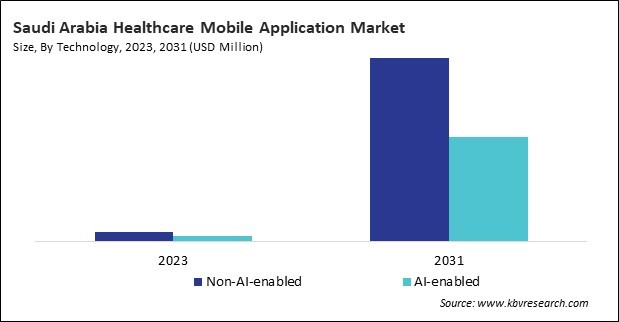The Latin America, Middle East and Africa Healthcare Mobile Application Market would witness market growth of 46.2% CAGR during the forecast period (2024-2031).
The Brazil market dominated the LAMEA Healthcare Mobile Application Market by Country in 2023, and would continue to be a dominant market till 2031; thereby, achieving a market value of $3,007.9 million by 2031. The Argentina market is registering a CAGR of 48.2% during (2024 - 2031). Additionally, The UAE market would witness a CAGR of 44.7% during (2024 - 2031).

The expansion of mobile pharmacies and e-prescription services has further transformed the healthcare mobile application landscape. Consumers can now order medicines online, receive digital prescriptions, and consult pharmacists remotely, reducing the need for physical visits to pharmacies. Many healthcare applications provide automated prescription refills, dosage reminders, and AI-powered drug interaction analysis, ensuring medication adherence and minimizing health risks. The convenience of doorstep medicine delivery and digital payment integration has made mobile pharmacy services an essential component of modern healthcare systems, further contributing to the market's expansion.
As the healthcare mobile application market grows, companies and developers focus on personalization, user experience, and AI-driven automation to enhance app functionality. The future of mobile healthcare will likely see greater integration of voice-enabled healthcare assistants, smart home health monitoring systems, and cross-platform interoperability to provide a seamless healthcare experience. With increasing investments, government support, and technological advancements, mobile healthcare applications are set to play a central role in shaping the future of digital health, improving patient care, and making healthcare more accessible.
The UAE is emerging as a leading healthcare innovation hub, with its Vision 2021 strategy emphasizing the role of mobile healthcare applications, big data, and AI-powered diagnostics in improving patient outcomes. Initiatives like the Dubai Health Strategy 2021 are accelerating the adoption of smart healthcare technologies, reinforcing the UAE’s position as a key player in mobile health solutions, medical tourism, and digital health transformation. Hence, with government-backed initiatives, growing healthcare investments, and the increasing adoption of mobile health technologies, the LAMEA region presents lucrative opportunities to expand the healthcare mobile application market in the coming years.
Free Valuable Insights: The Worldwide Healthcare Mobile Application Market is Projected to reach USD 138.32 Billion by 2031, at a CAGR of 43.1%
Based on Technology, the market is segmented into Non-AI-enabled and AI-enabled. Based on End Use, the market is segmented into Consumer, Hospitals/Healthcare Insurance Providers, Healthcare Payers, and Other End Use. Based on Platform, the market is segmented into Android, iOS, and Other Platform. Based on Type, the market is segmented into Fitness Products & Training, Appointment Booking & Consultation, Online Pharmacy, Diagnosis & Testing, Nutrition & Diet, Healthcare Insurance, and Remote Patient Monitoring & Others. Based on countries, the market is segmented into Brazil, Argentina, UAE, Saudi Arabia, South Africa, Nigeria, and Rest of LAMEA.
By Technology
By End Use
By Platform
By Type
By Country
Our team of dedicated experts can provide you with attractive expansion opportunities for your business.

